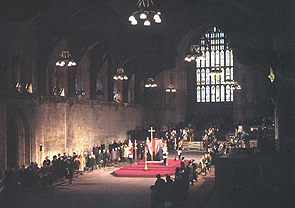 |
| Lying-in-State in Westminster Hall for Sir Winston Churchill. A hallmark of a State Funeral |
 |
| Baroness Thatcher resting in the Chapel of St. Mary Undercroft |
St. Mary Undercroft is itself a very special building. Small, intimate and atmospheric, it is a "Royal Peculiar", a status that befits a chapel located in the royal residence otherwise known as the Palace of Westminster (a.k.a. the Houses of Parliament). It may lack the melancholic grandure of Westminster Abbey or the sombre simplicity of St. Margaret's Westminster; but that matters not -- for it is Pugin at his best. The walls scream with echoes of the glories of Britain's spiritual past, are filled with sentiments of chivalry, nobility, truth, piety and the desire for spiritual elevation. It's atmosphere is almost unequalled in the chapels of this land.
 |
| Sufragette Emily Davison trampled by the horse of HM King Edward VII |
My first visit to the Undercroft occurred many years ago, when I was but a slight, svelte, naive swot. Late one evening, after a lengthy and jovial dinner in the Lords, a senior peer led me on my own into this dark, unlit crypt. Turning on a faint light, he opened the door to a broom cupboard and invited me to follow him in. My gut instinct was predictable but, being British, one did not wish to seem churlish or in any way unappreciative of the kind hospitality one had thus far been afforded. Therefore, with considerable trepidation, I followed said peer into this small broom cupboard. Once inside, "His Lordship" asked me to read the brass plaque that had been affixed to the inside of the door. Having read it, I relaxed immediately and any suspicions were well and truly banished. For this was the cupboard in which that famed suffragette Emily Davison had hidden on 1 January 1911, the day of the official national census. The consequence of her audacious act, was that she listed her address as the Houses of Parliament, a building in which she asserted her right to sit and sleep -- despite the fact that this was denied to all other members of her sex. Tragically it was Emily who was the sufragette now forever remembered for running to be trampled under the horse of King Edward VII at the Derby (pictured supra).
To commemorate Emily Davison's life and passion, the 2nd Viscount Stansgate (otherwise known as "Tony Benn") erected a small plaque to Emily, which is located on the inside of the door to the broom cupboard (and therefore rarely seen by anyone other than the most keen).
 |
| The Chapel of St. Mary Undercroft, a Royal Peculiar in the Palace of Westminster |
No comments:
Post a Comment